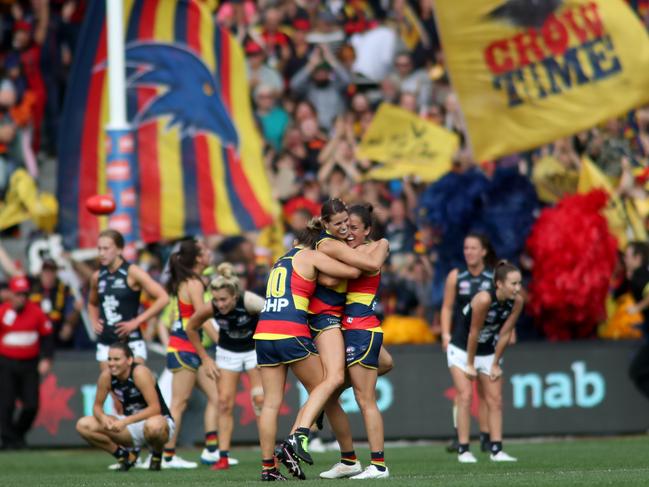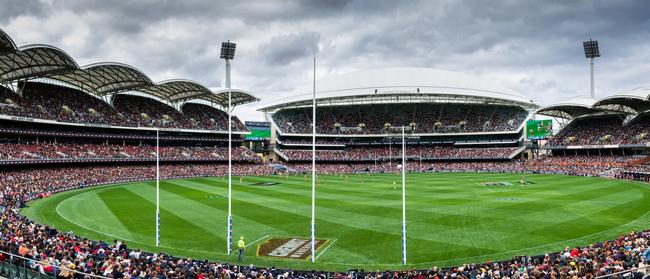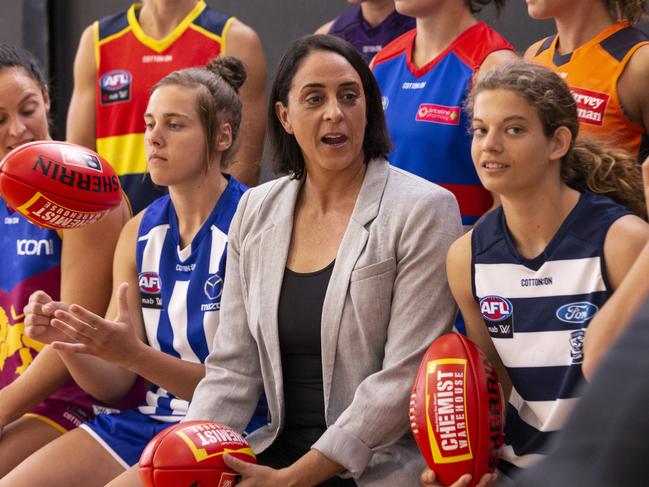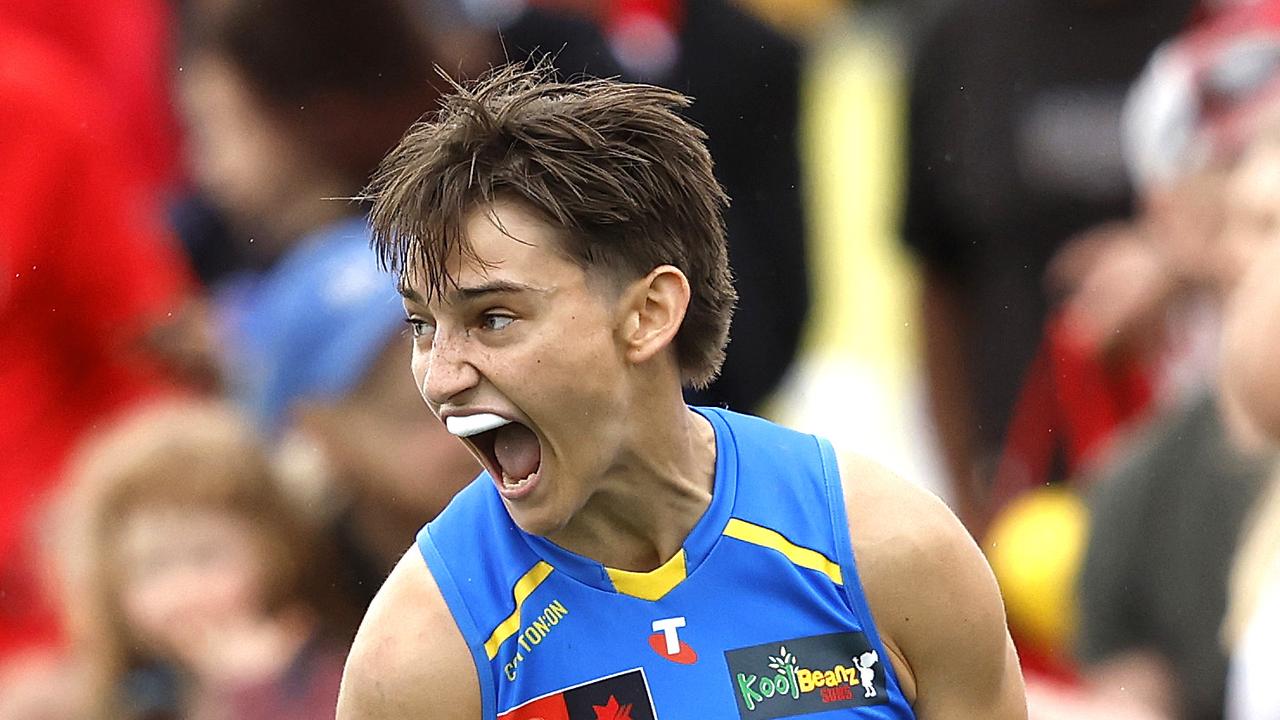AFL’s head of women’s football Nicole Livingstone reflects on 2019 and what was one remarkable season of AFLW
The AFL’s head of women’s football Nicole Livingstone looks back over the 2019 AFLW season and discusses what made it so extraordinary and how the league will continue to expand.

AFLW
Don't miss out on the headlines from AFLW. Followed categories will be added to My News.
- Matthew Clarke wins with simple footy mantra
- What it’s like to be on the Crows AFLW team bus
- Erin Phillips: I will never, ever forget that moment
Something happened this AFLW season; almost intangible, slightly unexpected. The 2019 season started bubbling in round one when more than 18,000 turned up to Kardinia Park to watch Geelong’s first game of women’s footy. It kept fizzing away when fans united to defend Carlton’s Tayla Harris against sexist online trolls.
And by season’s end, something had visibly shifted: it was evident that the skills of Australia’s 300 top-level female footballers had soared and a country’s mood had altered with it.
The AFL’s head of women’s football Nicole Livingstone saw it for herself on March 10, when she wandered around suburban Unley Oval as the Crows were taking on GWS in front of more than 7700 people.
“I was walking through the crowd because I was trying to find a ‘footy pie’ and I was seeing old blokes with beards and tinnies with their tinnie coolers on,” she recalls.
“And that was such a great indication that we are no longer catering for what we thought were our traditional fans ... families and kids, we’re actually getting the footy diehards now.”
Then three weeks later 53,034 people turned up to Adelaide Oval to watch the AFLW grand final between the Crows and Carlton. That is now the biggest crowd on record to attend a women’s sporting event.
And that figure was wildly “beyond expectation” Livingstone says.

So much so that the Oval’s caterers went through a staggering nine pallets of hot chips and at one point had to crack into the pallets that had been reserved for the upcoming Crows men’s game scheduled for the following Thursday.
Livingstone puts the season’s success down to a couple of things: firstly, the AFL tripled its marketing budget and coined the #GenW movement, secondly it expanded from eight to 10 teams, with Geelong and North Melbourne joining the league.
“As much as that made people nervous, I think having new teams coming in with new fans and clubs to follow, certainly gave it something more,” she says.
“We’ve often heard people say: ‘I’m not going to follow until my team’s in’, so given that we’ve got 14 teams next year then that gives us even more fans.”
Two of those four new teams are AFL powerhouses: West Coast and Richmond. And if the theory is true that fans will follow their club into the AFLW, that’s more than 150,000 brand new devotees to the game.
“AFLW is really resonating with the Australian public,” Livingstone says. “(Our players) are changing this nation and I’m really proud of where we’ve got to very quickly.
“And I’m proud of the players and the responsibility they take in trying to grow this.”
But with only 10 teams competing in 2019, the final crowd attendances were impressive: 244,224 people turned up across the nine weeks of the competition. Close to four million watched broadcasts of the games. The grand final alone was watched by 481,992 across the country.

But many questions remain about how the AFLW continues to expand as it grows to an 18-club competition: Will the 2020 season be lengthened beyond its current seven ‘home and away’ rounds? Will the skill level be lowered with 120 new players coming in via four new teams? Will there still be two conferences? When will the remaining four clubs — including Port Adelaide — enter the competition? Should further rule changes be made? How is the injury data looking in terms of ACLs and concussions?
All of these questions will be discussed by the AFL Women’s Competition Committee, of which Livingstone is a member, over the coming months.
“Certainly the length of the season will be discussed, but I think we need to remind people that we are trying to be the best AFLW competition we can be,” she says.
“One that helps us maintain crowds and maintain ratings and maintain interest, that then helps us build a strong, commercial offering to then go full circle to where can have full-time athletes. We’ve had this exceptional season three, but … we are so young in our evolution that we need to make sound decisions, take the time to make the decisions and make sure that we’re building a sustainable league.”

One thing that could have the AFL worried is the emergence of the Crows as an AFLW superpower. Given the league is run via a state-based draft — where new players nominate the state they want to play in — and its semi-professional nature means athletes juggle work commitments, the Crows have unfettered access to the best of South Australian and Northern Territorian talent … until Port enters. But no definitive timeline has been set for that.
“All of the other four clubs that are yet to have a licence or a date slated (Port, Sydney, Essendon, Hawthorn), they are all very keen and have signalled their intentions that they would like to enter the competition. So it’s just working out what that looks like and when.
“(For now) I think we concentrate on 2020 and bringing in those four new clubs (St Kilda, Gold Coast, West Coast, Richmond) and trying to do it as well as we’ve done it this year.”
And until that 2020 season begins, there remain the ripples of this “extraordinary” 2019 season, a two-month extravaganza that spurred an unflappable belief in women’s footy more than any other.
Originally published as AFL’s head of women’s football Nicole Livingstone reflects on 2019 and what was one remarkable season of AFLW


